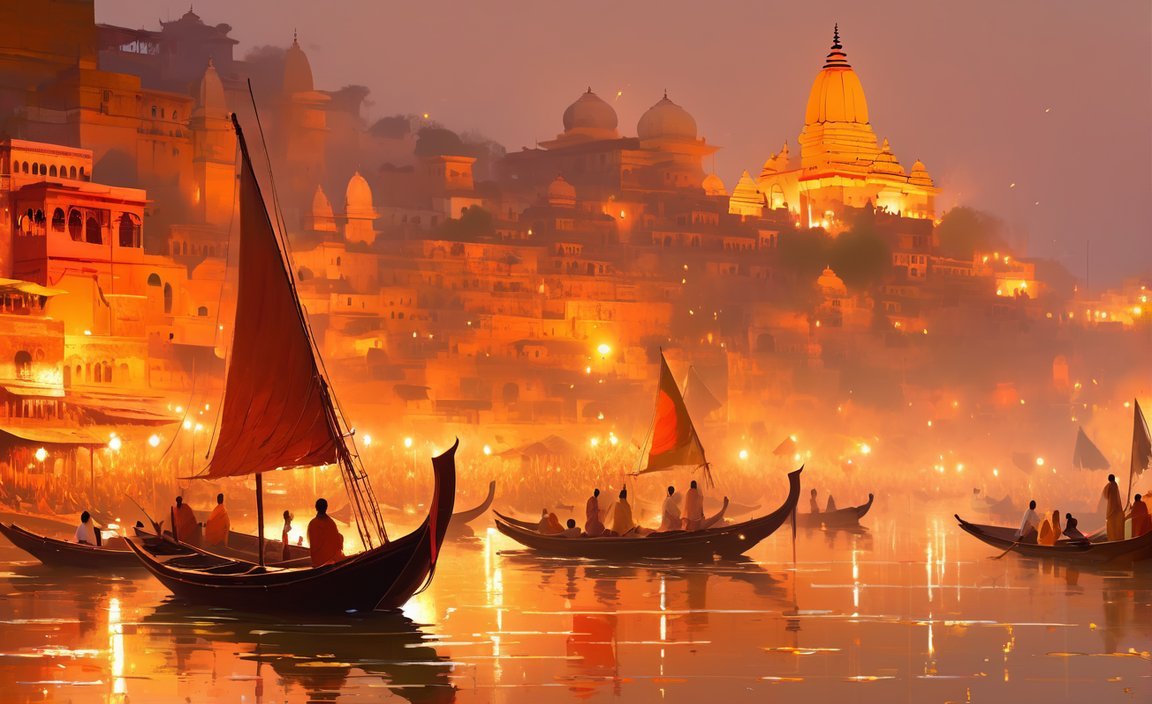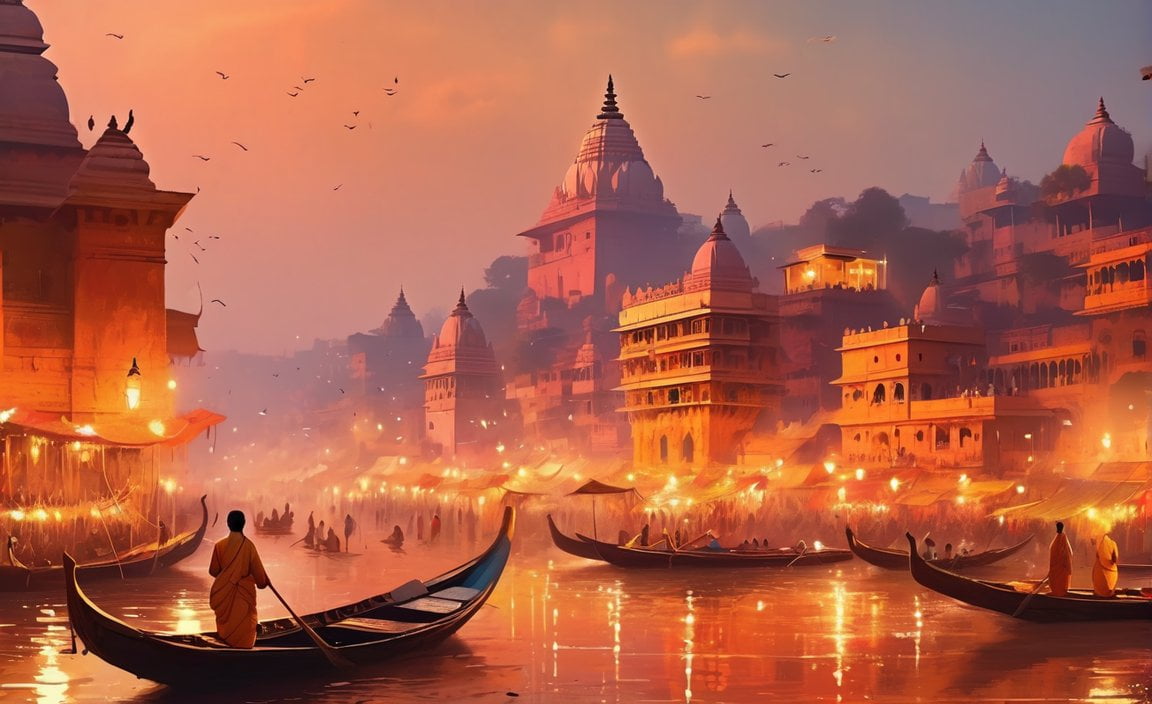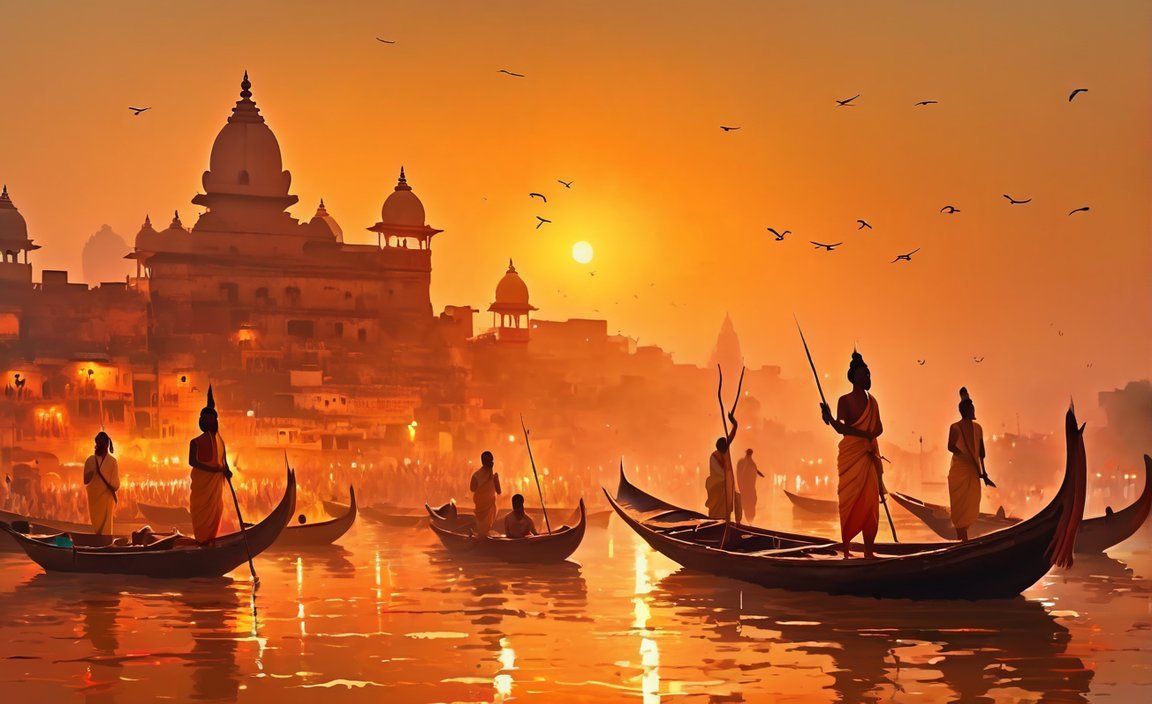Unveiling Varanasi: 10 Intriguing Facts about this Spiritual City

Step into the spiritual realm of Varanasi, a city brimming with ancient traditions and cultural wealth. As you meander through its narrow alleys and witness the rituals unfolding on the ghats, you’ll be captivated by the deep reverence that permeates every corner. From its mystical aura to its vibrant festivals, Varanasi is an enigmatic destination that beckons explorers and seekers alike. So, let’s embark on a journey to uncover 10 intriguing facts about this spiritual city that will leave you spellbound.
Key Takeaways:
- Varanasi is the oldest living city in the world, with a history of more than 3000 years.
- It is considered the abode of Shiva and Parvati.
- Dying in Varanasi is believed to bring salvation or Moksha.
- The city is known for its numerous Ghats, including the famous Dashashwamedh Ghat.
- Varanasi is also referred to as the ‘City of Light’.
- The city houses countless temples, making it a significant religious center.
- Mahasamshana is the largest cremation ground in Varanasi.
- The Aarti of the Divine Heart of Dashashwamedh is a famous ritual performed in Varanasi.
- Varanasi is famous for its beautiful Ghats along the Ganges river.
- Visitors can experience riding on the Ganges in a boat.
- Sarnath is a popular sightseeing spot near Varanasi, known for its Buddhist relics.
- Varanasi offers a variety of retail and dining options for tourists.
- The city is renowned for its weaving community, vibrant celebrations, and bustling markets.
10 Facts about Varanasi
Varanasi, often referred to as the spiritual capital of India, is a city that oozes ancient charm and enchantment. With a history spanning over 3000 years, it is the oldest living city in the world. Let’s delve into the spiritual significance, ancient traditions, and cultural wealth of this captivating city by exploring these 10 intriguing facts about Varanasi.
1. The Abode of Shiva and Parvati
Varanasi is believed to be the holy abode of Lord Shiva and his consort, Parvati. It is said that the city was created by Lord Shiva himself, making it an important pilgrimage site for followers of Hinduism.
2. The Gateway to Salvation
Dying in Varanasi is considered extremely auspicious and is believed to bring salvation or Moksha. It is believed that being cremated on the banks of the sacred Ganges River in Varanasi releases the soul from the cycle of birth and death, leading to eternal liberation.
3. The City of Ghats
Varanasi is adorned with numerous Ghats, which are steps leading down to the banks of the Ganges River. These Ghats serve as important cultural and spiritual hubs, witnessing a constant flow of rituals, ceremonies, and bathing rituals. The Dashashwamedh Ghat is particularly famous for its grand Aarti ceremony.
4. The City of Light
Varanasi is often referred to as the “City of Light” because of its spiritual aura and the belief that it radiates divine light. It illuminates the mind, dispelling darkness and ignorance.
5. A Melting Pot of Religions
Varanasi is a significant religious center for not only Hindus but also for Buddhists, Jains, and Muslims. The city boasts a harmonious blend of different religious traditions, with countless temples, mosques, and gurudwaras coexisting peacefully.
6. The Largest Cremation Ground: Mahasamshana
Mahasamshana, the largest cremation ground in Varanasi, is an intriguing sight. Here, funeral pyres burn round the clock, symbolizing the transient nature of life and serving as a constant reminder of the inevitability of death.
7. The Divine Heart of Dashashwamedh Aarti
One of the most famous rituals performed in Varanasi is the Aarti of the Divine Heart of Dashashwamedh. During this grand ceremony, priests adorned in traditional attire chant hymns and perform intricate fire rituals, mesmerizing spectators with the rhythmic movements of lamps as they pay homage to the river Ganges.
8. Serene Ghats Along the Ganges
Varanasi’s Ghats along the Ganges River are not only spiritually significant but also offer tranquil spots for introspection and rejuvenation. Visitors can witness the ebb and flow of life as locals and pilgrims engage in prayer, bathing, and ceremonial rituals.
9. Experiencing the Ganges
To truly immerse themselves in the spirit of Varanasi, visitors can take a boat ride on the sacred Ganges River. As they glide along the gentle waves, they can witness the city’s magnificent Ghats, temples, and ancient architecture from a unique vantage point.
10. Sarnath: A Spiritual Pilgrimage
Located near Varanasi, Sarnath is a popular sightseeing spot renowned for its Buddhist relics. This is the place where Lord Buddha first taught the Dharma after attaining enlightenment. Visitors can explore ancient ruins, meditation centers, and various Buddhist temples, immersing themselves in the serene ambiance.
Varanasi, with its rich spiritual heritage and cultural wealth, continues to enthrall and inspire visitors from around the globe. Its myriad facets, from ancient traditions to vibrant markets, offer a profound glimpse into the soul of this mystical city. You cannot help but be enchanted by the divine energy that reverberates through its streets and weave of its existence.
Check out these 10 fascinating facts about Indian culture that will leave you amazed. From vibrant festivals to rich traditions, Indian culture is a treasure trove of wonders. Explore more about it here.
Discover 10 intriguing facts about Indianapolis, from its iconic speedway to its vibrant arts scene. Quench your curiosity and find out more here.
Unearth the secrets of the ancient Indus Valley Civilization with these 10 mind-blowing facts. Marvel at their advanced urban planning and sophisticated drainage systems. Dive deeper into their fascinating world here.
Prepare to be enchanted by the charm of Prince Edward Island as you explore 10 captivating facts about this Canadian province. From its stunning beaches to its delicious seafood, there’s something for everyone. Discover more here.
Experience the legacy and prestige of Princeton University through these 10 remarkable facts. Be inspired by the notable alumni and delve into the historic achievements of this renowned institution. Begin your journey here.
Immerse yourself in the rich history and cultural heritage of Quebec with these 10 captivating facts. From its picturesque landscapes to its tantalizing cuisine, Quebec is a true gem. Uncover its hidden treasures here.
Step into the vibrant city of Toronto and uncover 10 fascinating facts that make it a true metropolis. From its diverse neighborhoods to its iconic landmarks, Toronto never fails to impress. Start exploring here.
Embark on a journey through the wonders of Toronto, Canada, with these 10 incredible facts. Discover the city’s multicultural vibe, world-class attractions, and thriving arts scene. Let your curiosity guide you here.
The Fascinating Rituals and Ceremonies at the Ghats of Varanasi
Varanasi, a captivating city in Northern India, is revered for its mystical ghats that lead down to the sacred river Ganges. These ghats not only hold deep religious significance but also serve as a gateway to the vibrant cultural heritage of Varanasi. Let’s dive into the intriguing rituals and ceremonies that take place at the ghats, offering a glimpse into the spiritual essence of this ancient city.
1. A Melting Pot of Spiritual Activities
The ghats of Varanasi come alive with spiritual activities throughout the day, making it a hub of religious fervor and devotion. From the crack of dawn to the late hours of the night, you’ll witness rituals, ceremonies, and religious performances that showcase the deep-rooted spirituality of the city.
2. The Ganga Aarti: An Enchanting Evening Ritual
One of the most mesmerizing rituals at the ghats of Varanasi is the Ganga Aarti, a daily evening ceremony that pays homage to the sacred river Ganges. As twilight descends, the ghats are illuminated with countless oil lamps, and priests clad in vibrant attire perform rhythmic prayers and hymns. The aura created by the flickering flames and the soul-stirring chants is truly enchanting.
3. Respecting the Rituals
While visiting the ghats, it’s essential to maintain a respectful distance from the religious ceremonies taking place. These rituals hold immense significance to the devotees, and observing them from afar allows you to embrace their sacredness without intruding.
4. The Controversy Surrounding Cremations
Varanasi’s ghats witness an astonishing number of cremations every year, with approximately 25,000 to 30,000 bodies being cremated on the various ghats. However, this practice has sparked controversy due to the environmental pollution it causes to the revered Ganges River. Efforts are being made to find sustainable alternatives while preserving the age-old traditions.
5. Popular Ghats That Beckon
Varanasi boasts 88 ghats, each with its own unique aura and significance. Among the popular ones are Dashashwamedh Ghat, where the grand Ganga Aarti takes place, Assi Ghat, known for its tranquility and yoga practices, and Manikarnika Ghat, the main cremation ghat that exemplifies the cycle of life and death.
6. Lassi Ghat: A Refreshing Retreat
For visitors seeking a refreshing break, Lassi Ghat is the place to be. This ghat is popular for its delectable lassi, a traditional Indian yogurt-based drink. Savor a chilled glass of lassi while enjoying the serenity of the Ganges River.
7. Where Rituals Intersect
At the ghats of Varanasi, bodies come together, touch, and partake in rituals and ceremonies. This intersection of life, death, spirituality, and tradition creates a unique blend of enigmatic experiences that are both thought-provoking and awe-inspiring.
8. Unveiling Cultural and Spiritual Significance
The ghats of Varanasi hold profound cultural and spiritual significance in the city’s history. They are a testament to the deep-rooted religious traditions and the unwavering faith of the people. Exploring the ghats allows us to delve into the soul of Varanasi, connecting with its rich heritage and divine essence.
9. A Mesmerizing Tapestry of Rituals and Ceremonies
The rituals, festivals, and ceremonies that unfold at the ghats of Varanasi are truly mesmerizing. From elaborate prayers to vibrant processions, every moment is a celebration of devotion and reverence. Being a part of these events offers an unforgettable experience, immersing you in the spiritual tapestry of Varanasi.
10. Approaching the Ghats with Respect and Awareness
As you embark on a journey to the ghats of Varanasi, it’s crucial to approach them with utmost respect and awareness. Understanding the significance of the rituals and the cultural heritage they embody fosters a deeper appreciation for this spiritual city and its traditions.
Key Takeaways:
- Varanasi’s ghats are a hub of spiritual activities that occur throughout the day.
- The Ganga Aarti is an enchanting evening ritual performed at the ghats, accompanied by oil lamps and soul-stirring chants.
- Respecting the rituals and ceremonies from a distance allows for a true understanding of their sacredness.
- The controversy surrounding cremations on the ghats highlights the need for sustainable alternatives.
- Popular ghats such as Dashashwamedh Ghat, Assi Ghat, and Manikarnika Ghat hold immense significance.
- Lassi Ghat offers a refreshing retreat with its renowned lassi, a traditional Indian drink.
- The ghats of Varanasi serve as a meeting point for life, death, spirituality, and tradition.
- The ghats hold profound cultural and spiritual significance in Varanasi’s history.
- The rituals and ceremonies at the ghats are both mesmerizing and thought-provoking.
- Visitors should approach the ghats with respect and awareness of their significance.
Sources:
1. India’s Varanasi — a sacred site on a river of rituals, University of Technology Sydney
2. Between Heaven and Earth – Exploring Varanasi’s Iconic Ghats, Savaari
Varanasi as a Hub of Cultural and Artistic Traditions
Varanasi, also known as Kashi, is a city brimming with cultural and artistic traditions. From its ancient temples to its renowned silk weaving industry, Varanasi showcases the essence of Indian culture through its vibrant art forms and historical heritage. Let’s uncover 10 intriguing facts about Varanasi as a hub of cultural and artistic traditions.
1. The Cultural Capital of India
Varanasi holds the esteemed title of being the cultural capital of India. Its rich cultural heritage and traditional art forms have shaped Indian culture for centuries. From music and dance to literature and poetry, Varanasi continues to inspire and nurture artistic talent.
2. Music, the Melody of Varanasi
Music thrives in Varanasi, with vocal and instrumental performances enriching the city’s cultural fabric. The vibrant sounds of classical music, such as Hindustani and Carnatic, can be heard resonating from its temples and music academies.
3. Dance, an Expression of Beauty
Varanasi is known for its contribution to classical dance forms such as Bharatanatyam and Kathak. These graceful and expressive dance styles find their roots in the city, where they continue to be practiced and cherished.
4. Banaras Silk Weaving
The world-renowned Banaras silk weaving industry flourishes in Varanasi. With a rich history spanning centuries, the city is a hub for exquisite silk sarees and fabrics. The intricate designs and fine craftsmanship of these textiles reflect the city’s artistic prowess.
5. Literary Haven
Varanasi has long been a literary haven, attracting poets, writers, and scholars from around the world. The city’s centuries-old tradition of storytelling and intellectual discourse has shaped its identity as a cultural hub.
6. Spiritual Significance
Varanasi’s cultural traditions are deeply rooted in Hinduism, Buddhism, and Jainism. The city serves as a significant religious pilgrimage destination, drawing devotees from far and wide to seek spiritual enlightenment and perform sacred rituals on the banks of the sacred Ganges River.
7. Temples of Worship
Varanasi is adorned with ancient temples that stand as testaments to its religious and artistic heritage. From the famous Kashi Vishwanath Temple to the Sankat Mochan Hanuman Temple, these architectural marvels hold both historical and spiritual significance.
8. Ghats: Confluence of Life and Culture
The ghats along the Ganges River form the heart and soul of Varanasi’s cultural identity. From the mesmerizing Dashashwamedh Ghat to the serene Assi Ghat, these riverfront steps witness an array of cultural activities and ceremonies, providing a glimpse into the ancient traditions of the city.
9. Culinary Delights
Varanasi’s diverse cuisine reflects its cultural diversity. Indulge in mouthwatering delicacies such as kachori sabzi, malaiyyo, and the famous Banarasi paan. The culinary experiences in Varanasi are a testament to the city’s vibrant and flavorful heritage.
10. Artistic Inspiration
Varanasi has captivated artists, poets, and photographers for centuries with its picturesque landscapes and timeless charm. Its unique blend of spirituality, culture, and artistic traditions offers a wellspring of inspiration for creative minds.
Citation:
– Travelogy India
– Varanasi.org.in
Key Takeaways:
– Varanasi is the cultural capital of India, showcasing diverse art forms and traditions.
– The city is renowned for its music, dance, and literature, reflecting its rich cultural heritage.
– The Banaras silk weaving industry is famous worldwide, representing the city’s artistic prowess.
– Varanasi’s temples and ghats hold deep religious and cultural significance, attracting pilgrims and tourists alike.
– The city’s cuisine reflects its cultural diversity, offering a delightful culinary experience.
– Varanasi’s picturesque landscapes and spiritual aura have inspired artists and creative minds for centuries.
The Varied Architectural Marvels of Varanasi, from Temples to Ghats
Varanasi, also known as Kashi, is a city brimming with historical and cultural significance. Its architectural marvels, ranging from temples to ghats, showcase the rich heritage and vibrant traditions of this sacred Indian city. Let’s dive into 10 intriguing facts about the architectural wonders that adorn Varanasi.
1. Kashi Vishwanath Temple: The Jewel of Varanasi [^2^]
One cannot talk about Varanasi’s architectural wonders without mentioning the iconic Kashi Vishwanath Temple. Dedicated to Lord Shiva, this temple is a masterpiece of intricate design, with its towering spires and ornate interiors. It attracts thousands of devotees from around the world, who come to seek blessings and witness the elaborate rituals performed here.
2. The Ghats: An Architectural Tapestry [^1^]
The ghats of Varanasi, a series of steps leading down to the holy River Ganges, are not just a cultural emblem but also architectural gems. These ghats hold immense religious and historical significance, with each ghat having its own unique story and purpose. From the grandeur of the Dashashwamedh Ghat to the serenity of Assi Ghat, the architectural diversity of the ghats is a sight to behold.
3. Dhamek Stupa: A Marvel from Ancient India [^1^]
Located near Varanasi, the Great Stupa, also known as Dhamek Stupa, stands as a testament to the architectural brilliance of ancient India. Built by Emperor Ashoka in the 3rd century BCE, this massive cylindrical structure is adorned with intricate carvings and serves as a significant Buddhist pilgrimage site. Its grandeur is a testament to the rich history and cultural heritage of the region.
4. Temples Galore: A Spiritual Haven
Varanasi is replete with temples, each distinguished by its unique architectural style. The Sankat Mochan Hanuman Temple, with its sprawling premises and intricate sculptures, is a sight to behold. The Tulsi Manas Temple, constructed in white marble, is renowned for its artistic beauty. From the tranquil Durga Temple to the elegant Bharat Mata Temple, the temples of Varanasi offer a glimpse into the city’s spiritual soul.
5. Mosques: A Mélange of Architecture [^1^]
Varanasi is not only a city of temples but also one of cultural diversity. The city is home to several mosques, reflecting the influence of Islamic architecture in this ancient city. The Alamgir Mosque, known for its unique blend of Hindu and Mughal architectural styles, stands as a testament to the harmonious coexistence of different cultures in Varanasi.
6. Museums: Preserving the Past [^1^]
Varanasi is also home to several museums that showcase the city’s rich cultural heritage. The Bharat Kala Bhavan Museum, situated within the Banaras Hindu University, exhibits a vast collection of ancient sculptures, paintings, and artifacts. The Archaeological Museum, housed in Sarnath, offers a deep insight into the region’s archaeological marvels and historical significance.
7. Architectural Splendor along the Ganges [^1^]
Walking along the riverfront of Varanasi, one is greeted by a picturesque panorama of architectural marvels. The ghats, adorned with grand palaces and intricate structures, provide a magnificent vision of Varanasi’s architectural heritage. From the ornate facade of Manmandir Ghat to the imposing structure of Raj Ghat, the riverfront is a treasure trove of architectural wonders.
8. The Mark of Marathas: Ghat Reconstruction [^1^]
During the reign of the Maratha Empire in the 18th century, the ghats of Varanasi underwent significant reconstruction. The Marathas left an indelible mark on the city’s architectural landscape by establishing new ghats and renovating existing ones. This period of reconstruction enhanced the grandeur and cultural significance of the ghats, solidifying their place in Varanasi’s architectural history.
9. The Living Heritage of Varanasi [^1^]
Varanasi’s architectural marvels not only exist in tangible form but also manifest in intangible heritage. The city’s music, art, craft, dance, and literature are integral components of its cultural wealth. The classical music and dance forms such as Bharatanatyam and Kathak, along with the renowned Banaras silk weaving industry, add a vibrant touch to Varanasi’s architectural tapestry.
10. An Eternal City of Lights [^2^]
Known as the “City of Lights,” Varanasi thrives on its spiritual aura, which permeates every aspect of its existence. The architectural marvels of Varanasi, from temples to ghats, illuminate the city’s cultural and spiritual richness. The divine blend of architecture and faith creates an enchanting tapestry that draws visitors from all corners of the world.
Key Takeaways:
- The Kashi Vishwanath Temple stands as a jewel among Varanasi’s architectural wonders, attracting devotees from around the world.
- The ghats of Varanasi are not only cultural symbols but also architectural masterpieces, each with its own unique story.
- The Dhamek Stupa near Varanasi showcases the architectural brilliance of ancient India and serves as an important Buddhist pilgrimage site.
- Varanasi’s temples showcase diverse architectural styles, reflecting the city’s spiritual essence.
- Mosques in Varanasi exhibit a blend of Hindu and Mughal architectural styles, representing the harmonious coexistence of cultures.
- Varanasi’s museums preserve and exhibit the city’s rich cultural heritage, offering a glimpse into its past.
- The riverfront of Varanasi presents a magnificent vision of architectural splendor, adorned with grand palaces and structures.
- The Maratha Empire’s reign marked a period of significant ghat reconstruction, enhancing the city’s architectural grandeur.
- Varanasi’s intangible heritage, including music, dance, craft, and literature, adds a vibrant touch to its architectural tapestry.
- Varanasi’s architectural marvels, along with its spiritual aura, earned it the title of the “City of Lights.”
Citations:
1. Culture and Heritage
2. Varanasi Guru

FAQ
Q1: What is the significance of Varanasi in Hinduism?
A1: Varanasi is considered the spiritual capital of India and is associated with Hinduism. It is believed to be the abode of Lord Shiva and Parvati, and dying in Varanasi is believed to bring salvation or Moksha.
Q2: How many ghats are there in Varanasi?
A2: Varanasi is famous for its numerous ghats along the Ganges river. The city has a total of 88 ghats, each with its own unique aura and significance.
Q3: What are some popular ghats in Varanasi?
A3: Some of the popular ghats in Varanasi include Dashashwamedh Ghat, Assi Ghat, and Manikarnika Ghat. Each ghat holds cultural and spiritual significance and is used for bathing rituals, religious ceremonies, and puja.
Q4: What is the significance of the Ganga Aarti in Varanasi?
A4: The Ganga Aarti is a famous ritual performed at some of the ghats in Varanasi. It is a daily evening ceremony where devotees offer prayers to the river Ganges, accompanied by music and the lighting of oil lamps.
Q5: What are some other attractions to explore in Varanasi?
A5: Apart from the ghats, Varanasi offers a variety of attractions for tourists. Visitors can explore the ancient temples, such as the Kashi Vishwanath Temple, and visit Sarnath, a popular sightseeing spot known for its Buddhist relics. The city also has a vibrant weaving community, bustling markets, and a diverse range of retail and dining options.












